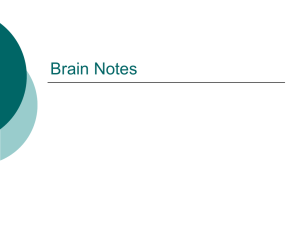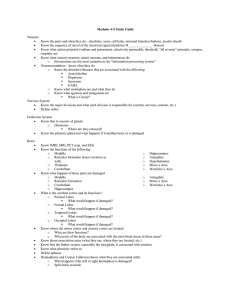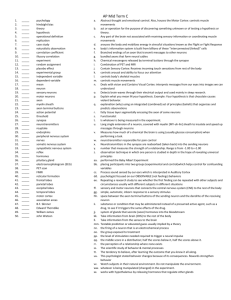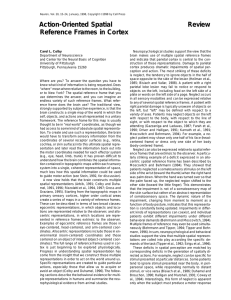Cognitive Neuroscience
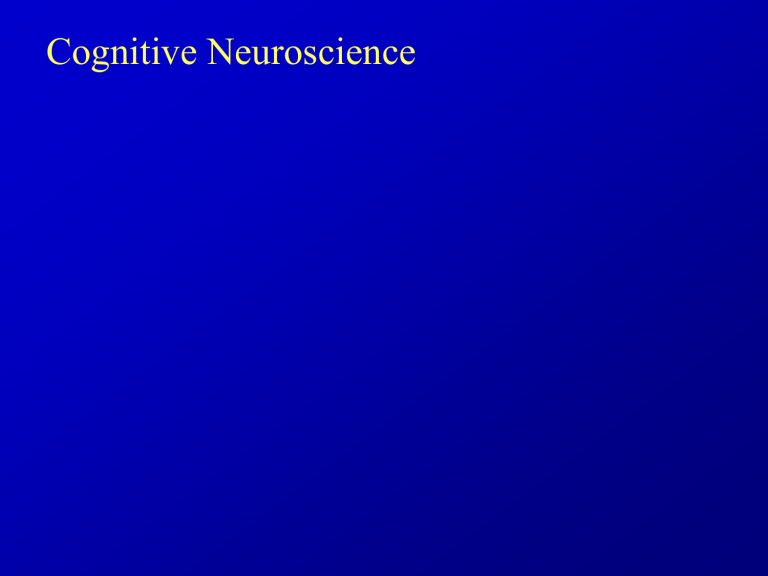
Cognitive Neuroscience
What are we doing with our brains right now?
• Feeling your chair
• Squirming (moving)
• Watching
• Listening
• Remembering
• Paying attention
• Sleeping
• Feeling anxious
• Feeling hungry
• What happens when you ask a question?
The Brain
• Approx 3lbs
• 1 trillion cells
• 100 billion neurons
• ½ of neurons are in cerebellum
• Each neuron has 5000 – 10,000 synapses
• Males and females differ, but only slightly
• Neurons transmit signals at speed of about 2 m/s
• There are more possible connections in your brain than there are atoms in the universe
Functional classification
Afferent or sensory neuron
: conduct impulses from the sensory organs to the central nervous system (brain and spinal cord)
Efferent or motor neuron
: conduct impulses from the central nervous system to the effector organs (such as muscles and glands) are called motor (or efferent) neurons
Interneurons
(also known as connector neurons or association neurons): connect sensory neurons to motor neurons.
Summary
Dendrites
– Receive in Modulate signals Omnidirectionally
– They are graded potentials – they decay as they travel
Axons
– Transmit signals in one direction and are ballistic (all or nothing)
– Have myelin sheaths which sustain the signal strengths (do not decay)
– Their axon buttons or knobs release neurotransmitters
Functional classification
The glial cells
• maintain the ionic environment
• modulate nerve signal propagation
• controls the uptake of neurotransmitters
• Protect by surrounding and buffering
• Speed transmission by forming myelin sheaths
Thinking Machines
Pinker, How the Mind Works
• How do you get neurons to represent simple logical functions?
• By setting the threshold
• This requires pre-wiring
• But cannot pre-wire for every thing in the world like mouse or justice.
Thinking Machines
Pinker, How the Mind Works
• Instead of oneneuron-onesymbol the brain uses distributed representation
• Many categories combined (e.g., crispy, green, edible) sum up to create one value
(e.g., celery)
Thinking Machines
Pinker, How the Mind Works
• Turn the network upside down, and you can represent the fuzzy quality of logic where tokens can be more or less good examples of a category.
• Here the item tomato only lights up some of the qualities for fruit
Thinking Machines
Pinker, How the Mind Works
• The neuron at the top is removed and the correlations amongst the nodes is preserved.
• The everything-connects-toeverything is called autoassociator, and has five features in common with human pattern recognition.
Thinking Machines
Pinker, How the Mind Works
•
Five features of Auto-associators
1.
Reconstructive and content addressable memory
– Specifying an item in memory automatically lights up a copy or version of that memory anywhere else. If you light one part of the network, if the weights are strong enough, the parts will light up. So you can recognize a word that has ‘mudsplashes’ on it.
2.
Graceful degradation. Do not discard the whole percept because of one faulty piece of information (e.g., PRITN,
HELF)
3.
Constraint satisfaction.
– Sinned a pin does not make sense.
– But s end a pen does even though the sounds are very similar.
– With logic you have to test each possibility. With auto-associator the context is intrinsic to the network, and the most meaningful evaluation emerges. Ambiguities are allowed: Necker Cube.
Thinking Machines
Pinker, How the Mind Works
•
Five features of Auto-associators
4. Generalizes automatically.
– E.g., bottom row is distributed pattern for an animal
(parrot).
The top row are the features of the category the animal belongs to (feathers, beak, flies).
The relationship amongst the features of a category have an intrinsic correlation.
5. Learn from examples, where learning is a change in the weights.
Signal Detection Theory REVISTED:
Think About This
• Each cell has a criteria for firing
• criteria shift
• No one neuron firing is sufficient information, the meaning is in the average rate in a given population .
White Matter and Grey Matter
• Rabbit, Raccoon,
Cat, Camel,
Kangaroo,
Baboon, Monkey,
Human
Evolution of Human Brain
• Tri-Partite Structure of
Brain
Garage Floor: Brainstem
First Floor: Limbic System
Top Floor: Cerebral Cortex
• Frontal
– Reasoning & Planning
• Parietal
– Touch, Temperature, Pain, &
Pressure
• Temporal
– Auditory & Perceptual processing
• Occipital
– Visual processing
Lobes of the Cerebral
Cortex
The Cortex
“The Bark”
Prefrontal
Cortex
• Recall the order of things
• Provides the brakes on impulse control
– Damage can produce
Tourette’s like symptoms of tic or exclaiming obscenities
Story of Phineas Gage: Damage to the
Prefrontal cortex
Gage was fitful, irreverent, indulging at times in the grossest profanity (which was not previously his custom), manifesting but little deference for his fellows, impatient of restraint or advice when it conflicts with his desires, at times pertinaciously obstinate, yet capricious and vacillating, devising many plans of future operations, which are no sooner arranged than they are abandoned in turn for others appearing more feasible. A child in his intellectual capacity and manifestations, he has the animal passions of a strong man. Previous to his injury, although untrained in the schools, he possessed a well-balanced mind, and was looked upon by those who knew him as a shrewd, smart businessman, very energetic and persistent in executing all his plans of operation.
In this regard his mind was radically changed, so decidedly that his friends and acquaintances said he was 'no longer
Gage.’
Testing the Prefrontal cortex: The
Wisconsin Card Sorting task
• The patient is told to sort the cards, but they are not told how to sort.
• But they are told if they matched the cards correctly.
• They must use their memory for the order of things to figure out the rules of the sorting.
• It took an entire manual to score the test, nowadays it is done on the computer.
Primary Somatosensory and Motorsensory Cortex
Goals
• Finish Neuroanatomy
– Parietal Lobes
– Broca and Wernicke’s areas
– Hemispeheric Specialization
• demo
– Amygdala and Hippocampus
– Basal Ganglia and Cerebellum
– Talk Rama
– Start Vision
Parietal Lobes
• Integrates sensory input
–
Amodal, Bi-modal and multi-modal cells
• Assigns spatial coordinates to objects
–
Allocentric coordinates
• Not Egocentric coordinates (frontal lobes)
Parietal Lobes Deficits
• Gerstmann's Syndrome
– right-left confusion,
– difficulty with writing (agraphia)
– difficulty with mathematics (acalculia).
– disorders of language (aphasia)
– inability to perceive objects normally (agnosia).
• Balint’s
Can only see one object overlapping at a time.
• Right Parietal lesions
– Neglect, Ignoring the left side of objects or one’s own body.
– difficulty in making things (constructional apraxia),
– denial of deficits (anosagnosia)
– and drawing ability.
Broca and Wernicke’s Areas:
Speech Production and Comprehension
Broca and Wernicke’s Areas:
Speech Production and Comprehension
Broca’s Area
: Speech Production
Example: Ah ... Monday ... ah, Dad and Paul Haney [himself] and Dad
... hospital. Two .. .ah, doctors ... and ah ... thirty minutes .. .and yes
... ah ... hospital. And, er,
Wednesday ... nine o'clock. And er
Thursday, ten o'clock .. .doctors.
Two doctors ... and ah ... teeth.
Yeah, ... fine.
Wernicke’s Area: Speech comprehension
Examiner Yeah, what's happening there (picture of a boy taking a cookie)?
C.B. I can't tell you what that is, but I know what it is, but I don't now where it is.
But I don't know what's under. I know it's you couldn't say it's ... I couldn't say what it is. I couldn't say what that is. This shu-- that should be right in here.
That's very bad in there. Anyway, this one here, and that, and that's it. This is the getting in here and that's the getting around here, and that, and that's it. This is getting in here and that's the getting around here, this
Lateralization: The Right and Left
Hemispheres
• Myths and oversimplifications
Corpus Callosum
Methods in Split
Brain Research
• Z-lens
• Wada Test
“Testintracarotid sodium amobarbital procedure”
Local Global
• Lesions in LH produce deficits in local perception
• Lesions in RH produce deficits in Global
General
Trends in
Hemispheric preferences
Findings in Lateralization
• Handedness
– Almost all dextrals are LH dominant, and a majority of sinestrals are LH dominant, but they vary more greatly.
•
Right hemisphere superiority
– in musicality, emotionality and spatial ability.
– palpate an object and successfully identify it, while the lefthemi is more hesitant making a running commentary.
•
Emotionality
– Both hemispheres display appropriate reaction to the imag, even the left hemisphere which cannot see the image. So RH is doing the computing and passing it on somehow .
• RH Maximizes , LH Frequency Matches .
Function of Limbic System
Thalamus
“Bed Chamber”
• Relays sensory information throughout the cortex
Limbic System: “The Boundary”
The Amygdala
Amygdala and Its Disorders
• Tameness
• Willingness to approach normally fear-inducing stimuli, including a live rat and a live snake.
• Inappropriate sexual behavior (e.g. directed towards inanimate objects).
• Tendency to investigate the environment orally and put inedible objects in mouth (suggesting inability to distinguish food from non-food).
• Originally called “psychic blindness”, the syndrome appears to indicate an overall deficit in the ability to identify the motivational significance of stimuli.
Hippocampus
Anatomy of
Memory
Amygdala : emotional memory and memory consolidation
Basal ganglia & cerebellum : memory for skills, habits and
CC responses
Hippocampus : memory recognition, spatial, episodic memory, laying down new declarative long-term memories
Thalamus , formation of new memories and working memories
Cortical Areas : encoding of factual memories, storage of episodic and semantic memories, skill learning, priming.
Hindbrain
Quick Summary
The End
• Back-up Slides

